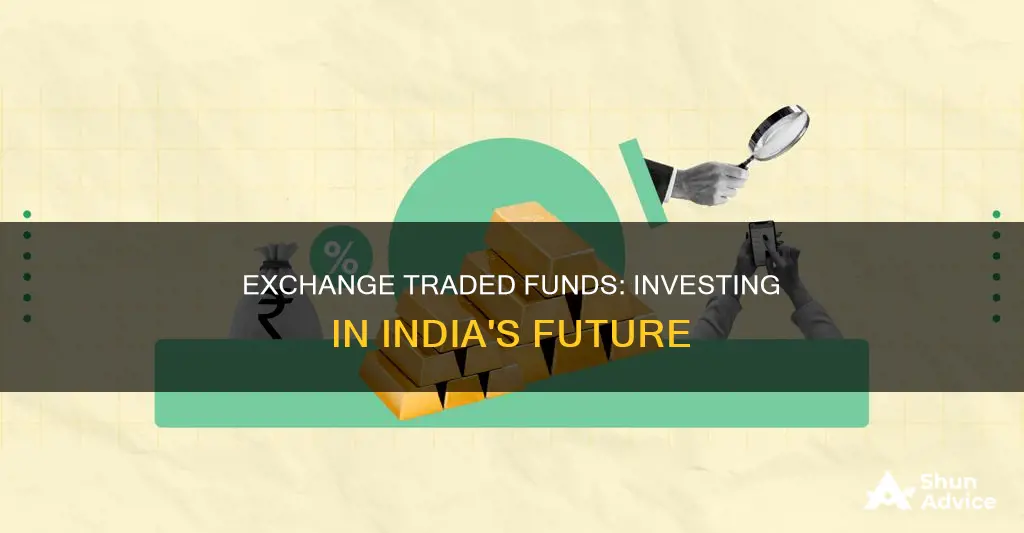
Exchange-Traded Funds (ETFs) are a popular investment vehicle in India, offering investors a simple and cost-effective way to diversify their portfolios. ETFs are similar to mutual funds but trade on stock exchanges like individual stocks, allowing investors to buy and sell throughout the trading day. They are passively managed, aiming to replicate the performance of a specific index, such as the Sensex or Nifty 50, rather than trying to outperform the market. ETFs provide exposure to a basket of stocks, bonds, or commodities, offering instant diversification at a lower cost compared to traditional mutual funds. With their flexibility, transparency, and tax efficiency, ETFs have become an attractive option for investors in India seeking a balanced and affordable investment strategy.
| Characteristics | Values |
|---|---|
| Definition | Exchange Traded Funds (ETFs) are funds traded on stock exchanges, like shares. |
| Comparison to Mutual Funds | ETFs are bought and sold throughout the trading day, have lower costs, and often replicate market indexes. Mutual funds are bought or sold at the net asset value (NAV) at the end of the trading day. |
| Comparison to Index Funds | ETFs are traded on stock exchanges like shares, while index funds are not. Index funds are priced at the close of the trading day based on the NAV of underlying securities. |
| Comparison to Actively Managed Funds | ETFs are passively managed, aiming to replicate the performance of an index. Actively managed funds, like most mutual funds, aim to outperform the market through active trading of assets. |
| Benefits | Instant diversification, cost-effectiveness, flexibility, tax efficiency, and transparency. |
| Types | Index ETFs, Sector ETFs, Bond ETFs, and Commodity ETFs. |
| How to Invest | Open a brokerage or demat account, select the desired ETF, and transfer funds. |
What You'll Learn

The benefits of investing in ETFs
Exchange-Traded Funds (ETFs) are a popular investment choice in India, especially among retail investors and youngsters. ETFs are a unique investment vehicle structured like a mutual fund but traded like a stock. Here are the key benefits of investing in ETFs in India:
Diversification:
ETFs offer instant diversification, allowing investors to spread their investments across a wide range of assets, sectors, and securities in a single transaction. By investing in a range of ETFs, investors can build a well-diversified portfolio, reducing their risk of losses and helping them achieve their financial goals.
Cost-Effectiveness:
ETFs are known for their low costs. They typically have lower expense ratios compared to actively managed funds like mutual funds. The money invested in ETFs largely goes towards investing, rather than management fees, making them a cost-effective option for investors.
Liquidity and Flexibility:
ETFs offer ease of liquidity as they can be easily bought and sold on exchanges, providing flexibility to investors. There is no specific lock-in period, and the funds can be liquidated within a short timeframe, similar to equity stocks. This liquidity feature is especially attractive to investors who are new to the equity market and want the option to quickly sell their investments during trading hours if needed.
Tax Efficiency:
ETFs are considered tax-efficient investments. They are structured as funds, so investors are generally not required to pay capital gains taxes on their investments, optimising their actual gains. ETFs are subject to the same long-term capital gains tax rates as stocks, but their gains are taxed at a lower rate than mutual funds.
Passive Investment Strategy:
ETFs are passively managed, meaning they are designed to mirror the performance of an underlying stock market index. This means investors in ETFs do not need to be experts in market movements or spend excessive time on research. Once purchased, the investments automatically follow the particular index the ETF replicates, and portfolio managers ensure the ETF resembles the benchmark index as closely as possible.
Accessibility:
ETFs provide investors with access to a wide range of Indian stocks, bonds, commodities, and other securities. They offer exposure to the booming Indian economy and its growth potential, without requiring investors to buy individual stocks.
In summary, ETFs in India provide a cost-effective, flexible, and diversified investment approach, making them attractive to both small and large investors, especially those seeking long-term investments and looking to achieve market returns.
Key Considerations for Investing in Algorithmic Trading Funds
You may want to see also

How ETFs work
Exchange-Traded Funds (ETFs) are funds traded on stock exchanges, like shares. They are similar to mutual funds but are traded like stocks on a stock exchange. ETFs are considered passively managed funds as they aim to mirror the performance of a specific index, such as the Sensex or Nifty 50, rather than trying to outperform it. This means that they try to be the market, not beat the market.
ETFs are a basket of stocks, bonds, or commodities that reflect the composition of an index. The current trading value of an ETF is derived from the net asset value of the underlying stocks or commodities it represents. ETFs provide investors with broad exposure to entire stock markets, specific sectors, or asset classes, such as bonds or commodities. They are typically associated with lower fees and higher liquidity than mutual funds, making them an attractive option for investors.
ETFs are bought and sold on exchanges throughout the trading day, offering intraday trading flexibility. They can be purchased on the exchange or directly from the fund. When investing in ETFs, investors need to consider the total expense ratio, tracking error, and liquidity.
ETFs work by pooling money from multiple investors to create a diverse portfolio that mirrors a specific index, sector, or asset class. The value of an ETF share is closely tied to the worth of its underlying assets, rising and falling with their value. This direct link between the ETF and its underlying assets provides transparency, helping investors make better-informed decisions.
Fund providers sell shares in the ETF to investors, giving them a stake in the fund. ETFs focus on a specific group of assets, and investors buy and sell shares throughout the trading day on exchanges. This makes ETFs an easy and affordable way to diversify across markets while maintaining liquidity and flexibility.
Seeking Investment Funds for Your Dream Zoo
You may want to see also

Types of ETFs
Exchange-Traded Funds (ETFs) come in a variety of options for investors, each with its own unique characteristics and advantages. Here are the main types of ETFs available in India:
Index ETFs
Index ETFs are the most common type of ETF. They track specific market indices like Nifty, Sensex, Nifty 100, or S&P BSE Sensex. The returns of these ETFs depend on the performance of the specific indices they follow. These funds are passively managed, aiming to mirror the performance of the underlying stock market index.
Sector or Thematic ETFs
Sector ETFs focus on specific market segments or sectors such as healthcare, technology, banking, or pharmaceuticals. They allow investors to gain exposure to a particular industry without having to pick individual stocks. These ETFs are designed to replicate the performance of a specific sector.
Bond ETFs
Bond ETFs provide investors with access to a range of fixed-income instruments, including government bonds, debentures, and corporate bonds. They combine the benefits of debt investments with the flexibility of stock investments and the simplicity of mutual funds. Bond ETFs are typically passively managed and designed to provide steady returns with low default risk.
Commodity ETFs
Commodity ETFs track the performance of commodities such as gold, silver, oil, or natural gas. Gold ETFs, in particular, offer investors a convenient way to invest in precious metals digitally, without the need for physical storage. The value of gold ETFs rises and falls with the market price of gold. Silver ETFs are also available in India as an alternative investment option for portfolio diversification.
Equity ETFs
Equity ETFs combine investing in equity stocks and equity mutual funds. They are traded on stock exchanges, allowing investors to buy and sell at market prices in real-time. These ETFs are typically classified as market-based, sector-based, or factor-based. Market-based equity ETFs are categorised according to market capitalisation, including small-cap, mid-cap, and large-cap funds. Sector-based equity ETFs invest in different companies within a specific sector. Factor-based equity ETFs track indices based on factors like volatility, momentum, and size.
International ETFs
International ETFs allow investors to invest directly in foreign companies and mirror the indices of global markets or country-specific indices.
Investing in Infrastructure: Building Tomorrow's Economy Today
You may want to see also

How to analyse ETFs by sector and asset class
When analysing exchange-traded funds (ETFs) by sector and asset class, investors can gain exposure to specific industries or asset types. This allows for targeted investments that align with one's convictions, preferences, and risk tolerance. Here are some key considerations for analysing ETFs by sector and asset class:
Sector ETFs:
Sector ETFs invest in a specific industry or sector, such as energy, technology, healthcare, or financials. Sector ETFs are available for each Global Industry Classification Standard (GICS) sector, as well as unique sectors like the internet, e-commerce, or artificial intelligence. When analysing sector ETFs, consider the following:
- Industry Focus: Identify the sector or industry in which you want to invest. This could be based on your expertise, interest, or expected growth potential.
- Diversification: Sector ETFs provide exposure to a diverse range of stocks within a specific sector. This helps reduce the risk associated with investing in individual stocks.
- Performance and Risk: Evaluate the historical performance and risk metrics of the sector ETF. Compare it with other sector ETFs or broad market indices to understand its returns, volatility, and potential risks.
- Liquidity: Sector ETFs are known for their high liquidity, which minimises tracking errors from the underlying index. Ensure the ETF has sufficient trading volume to facilitate easy entry and exit.
- Index Tracking: Most sector ETFs track a representative basket of stocks within a specific sector. Analyse the index composition to ensure it aligns with your investment objectives.
Asset Class ETFs:
Asset class ETFs allow you to invest in a variety of asset classes beyond traditional equities, such as precious metals, bonds, commodities, or foreign markets. When analysing asset class ETFs, consider the following:
- Diversification Benefits: Different asset classes often complement each other by reacting differently to market movements. Diversifying across asset classes can help spread risk and enhance portfolio resilience.
- Risk and Return Profile: Each asset class has its own risk and return characteristics. Evaluate the historical performance, volatility, and potential drawdowns associated with the asset class you're considering.
- Cost Considerations: Expense ratios and management fees can vary across asset classes. Ensure you understand the total expense ratio (TER) and any other associated costs before investing.
- Investment Objectives: Different asset classes serve different investment objectives. For example, bonds may provide stable income, while commodities can offer inflation protection. Align your investment choices with your financial goals.
- Geographic Exposure: Some asset class ETFs provide exposure to specific regions or countries. If you're interested in investing in a particular geographic area, look for ETFs that focus on that region.
By carefully considering these factors, you can make informed decisions when analysing ETFs by sector and asset class. This approach will help you construct a well-diversified portfolio that aligns with your investment goals and risk tolerance.
Smart Mutual Fund Investments: 16K Options
You may want to see also

How to select the right ETFs for your portfolio
When selecting the right Exchange Traded Funds (ETFs) for your portfolio, it is important to carefully assess your investment goals, risk tolerance, and time horizon. Here are some key considerations and steps to help you choose the right ETFs:
Investment Goals and Risk Tolerance:
Clearly define your investment goals, such as long-term growth, income generation, or capital preservation, and consider your risk tolerance level. This will help you choose ETFs that align with your specific objectives.
Diversification:
Diversification is a key aspect of building a robust investment portfolio. Look for ETFs that span various asset classes, such as stocks, bonds, commodities, and even specific sectors or industries. This will help mitigate risk and provide a well-rounded exposure to different market segments.
Research and Evaluation:
Thoroughly research and evaluate each ETF before investing. Analyse the underlying holdings of the ETF, including the stocks, bonds, or commodities it tracks. Examine the expense ratio, performance history, and the fund's ability to track its underlying index. Compare different ETFs to find the ones that best match your investment strategy.
Seek Expert Guidance:
Consider seeking guidance from an experienced financial advisor who specializes in ETF investments. They can provide valuable insights and help tailor your ETF selections to your unique needs and circumstances. This ensures your portfolio is well-positioned to achieve your financial objectives while effectively managing risk.
Identify the Right Index:
ETFs are designed to track specific indices, such as the S&P CNX Nifty or BSE Sensex. Identify the index that aligns with your investment goals and provides the best exposure to your desired asset class or strategy. Look into the composition of the index, including its market capitalization and the weightage of different sectors or stocks.
Evaluate Tracking Error and Liquidity:
Assess the tracking error of the ETF, which measures the deviation of the ETF's returns from that of the underlying index. Aim for ETFs with minimal tracking error. Also, consider the liquidity of the ETF, as it impacts the efficiency of periodic investments. Evaluate trading volumes, bid-ask spreads, and the consistency between the ETF's price and its net asset value (NAV).
Periodic Review:
Remember that passive investments like ETFs also require periodic review. Monitor your ETFs for performance and suitability, and be prepared to make adjustments if they no longer align with your investment goals or if there are changes in the index composition that you are uncomfortable with.
By following these steps and considerations, you can make informed choices when selecting the right ETFs for your portfolio, ensuring they align with your investment strategy, risk tolerance, and financial objectives.
Mutual Fund Investing: Cutting Out the Broker
You may want to see also
Frequently asked questions
An Exchange Traded Fund (ETF) is a fund that is traded on a stock exchange, like a stock. ETFs are similar to mutual funds but are bought and sold in real-time at prices that change throughout the day. ETFs are passively managed and aim to replicate the performance of a particular market index, such as the Sensex or Nifty 50.
ETFs offer instant diversification, allowing investors to spread their money across various assets with a single investment. They are cost-effective, typically featuring lower expense ratios compared to traditional mutual funds. The flexibility of trading ETFs on stock exchanges provides easy access to markets, and ETFs often have tax efficiency and transparency.
To invest in ETFs in India, you need to have both a demat and a trading account with a stockbroker. You can then select the ETF that aligns with your investment goals and risk tolerance, transfer funds into your trading account, and purchase shares of the ETF.
Some popular ETF categories in India include Index ETFs, Gold ETFs, Bank ETFs, International ETFs, and Liquid ETFs. Index ETFs aim to track market indexes such as the Sensex or Nifty, while Gold ETFs offer exposure to the price of gold. Bank ETFs invest in a basket of banking stocks, International ETFs focus on foreign securities, and Liquid ETFs aim to enhance returns and reduce price risk by investing in short-term government securities.







